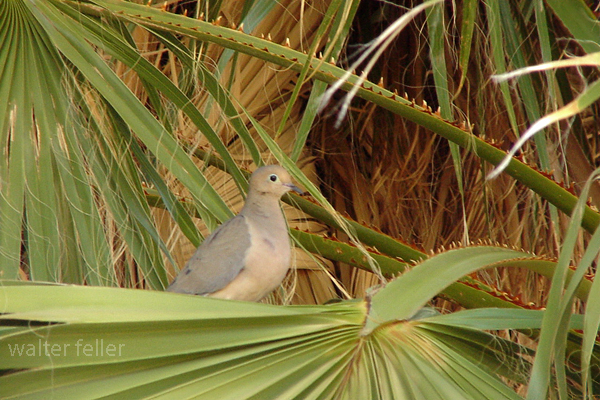Mourning Dove

The Mourning Dove (Zenaida macroura) is a medium-sized bird that is native to North and Central America. It is a member of the dove family, Columbidae. Here are some key features and facts about Mourning Doves:
Appearance:
Mourning Doves have a slender, streamlined body with a length of about 9-13 inches (23-33 cm). They have a soft, pale grayish-brown plumage with a slightly pinkish hue on the chest. The wings are pointed, and the tail is long and tapered with white edges.Cooing Sound:
One of the most distinctive features of Mourning Doves is their soft, mournful cooing sound, which is often described as a series of coos that sound like "coo-OOO-coo-coo."Habitat:
These doves are adaptable birds that can be found in a variety of habitats, including urban areas, open woodlands, farmlands, and grasslands.Diet:
Their diet primarily consists of seeds, grains, and occasionally fruits. They forage on the ground and are often seen picking seeds from the ground.Behavior:
Mourning Doves are known for their gentle and peaceful demeanor. They are usually monogamous and form strong pair bonds. During courtship, males perform aerial displays to attract females. They may also engage in mutual preening and other bonding behaviors.Nesting:
They build flimsy, platform-like nests made of twigs, grass, and other plant materials. Nests are often constructed on horizontal branches of trees or on man-made structures such as ledges, eaves, or even on the ground.Eggs and Incubation:
A typical clutch consists of two white eggs. Both parents take turns incubating the eggs, which hatch in about 14 days.Distribution:
Mourning Doves are found throughout North and Central America. They are one of the most widespread and abundant bird species in North America.Migration:
While some populations are resident year-round, others may migrate in response to seasonal changes in food availability.Symbolism:
In some cultures, doves, including Mourning Doves, are symbols of peace and love. They have been featured in various poems, songs, and art. Overall, Mourning Doves are common and widely recognized birds known for their gentle nature and distinctive cooing calls.The Mourning Dove diet consists of mainly small dry seeds, forcing a dependance on drinking water throughout the year. However, with their strong ability to fly they do not need to stay near waterholes. Doves drink continuously, by sucking and swallowing, up to six times faster than other birds, reducing the time required at available water. This is important as most predators are known to ambush their prey while drinking.
Also see > Bird: Prey: Herbivore: Diurnal
Mourning Dove
Zenaida macroura
Family: Columbidae Order: Columbiformes Class: Aves
DISTRIBUTION, ABUNDANCE, AND SEASONALITY
Common in a variety of habitats throughout the state, including croplands, pastures and
other grasslands, open chaparral, Great Basin and desert habitats, open hardwood,
hardwood-conifer, riparian, and low-elevation conifer. There is a general movement in fall and
winter from northern latitudes. These movements are especially noticeable in northeastern
California and in the northern sections of the southern deserts. Much less common in winter
in cold parts of the state.
SPECIFIC HABITAT REQUIREMENTS
Feeding: Feeds almost entirely on seeds of cereal grains, forbs, and grasses;
occasionally on snails in spring; less often on insects. Obtains food from ground by pecking.
For details see Browning (1959, 1962) and Grenfell et al. (1980).
Cover: Cover is provided by trees and shrubs and woodland and forest stands.
Reproduction: Nest is a loose platform of twigs on a horizontal limb or in crotch of tree, old
bird nest, or (rarely) on the ground. Nests in conifers and deciduous trees. Nest height
usually 1-6 m (3-20 ft) above ground.
Water: Drinks water once or twice daily (Grinnell and Miller 1944).
Pattern: Open woodlands, grasslands, croplands, and deserts all provide adequate
habitat. Requires a water source nearby.
SPECIES LIFE HISTORY
Activity Patterns: Yearlong, diurnal activity.
Seasonal Movements/Migration: Resident throughout the state except at highest
elevations. There is downslope movement in fall, and upslope movement in spring, in the
major mountain ranges of the state. Also a general movement south from northern latitudes
in fall from north of California, within the state, and into Mexico.
Home Range: In Missouri, Tomlinson et al. (1960) reported most feeding within 1.6 km
(1 mi) of nests, indicating a home range of no more than 10 km˛ (4 mi˛).
Territory: Territory 64-91 m (210-300 ft) in diameter in a moderately dense population in
urban Missouri (Jackson and Baskett 1964). In Ohio, Mackey (1954) found average diameter
of nesting territory to be 30 m (100 ft). In California, 3 to more than 40 pairs nest per 40 ha
(100 ac) in valley foothill hardwood and valley foothill riparian habitats (VanVelzen 1974).
Feeds outside nesting territory.
Reproduction: Breeds mostly from late January to late September (peak in May and
June); in California can breed almost all year, depending on weather (Nice 1923). Raises 2-6
broods a year. Almost invariably lays 2 eggs per clutch (range 1-3). Usually breeds solitarily,
but sometimes more than 1 nest in same tree. Male incubates much of day and female at
night, for 14-15 days. Young fed seeds and crop milk by both adults during nestling period of
13-15 days (VanVelzen 1974).
Niche: Adults or eggs preyed upon by domestic cats, falcons and accipiters, snakes, and
small mammals. Infection by Trichomonas, a protozoan, may be a significant mortality factor
(Rue 1973).
California Department of Fish and Game. California Interagency
Wildlife Task Group. 2005. California Wildlife Habitat Relationships version 8.1 personal computer program. Sacramento, California.